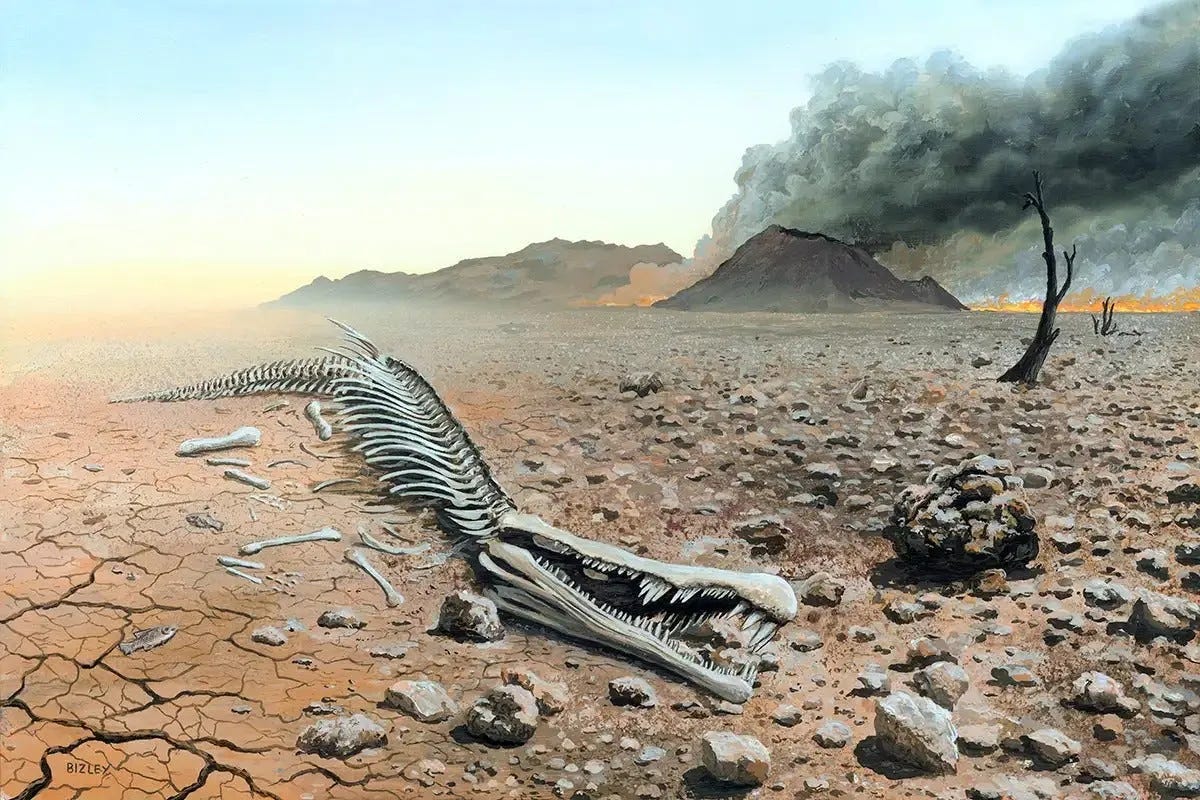
Let's consider MASS EXTINCTION. Since we are now living through the Sixth Extinction Event.
Roughly 252mya there was a Mass Extinction Event, the Permian-Triassic Extinction. It was so BAD that it's known as the “Great Dying” because it wiped out around 90% of life on the planet.

Here's what paleontology tells us that world probably would have looked like from space.
It was only about +4°C warmer than it was in 1850. Then it SUDDENLY warmed up. A LOT.

WTF happened?
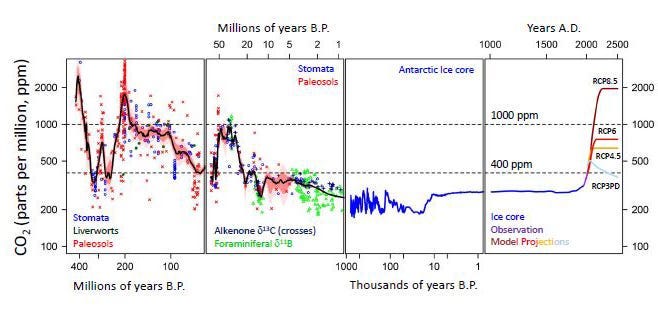
Well, CO2 levels in the atmosphere went CRAZY.
Six-fold increase of atmospheric pCO2 during the Permian-Triassic mass extinction - Nature…The Permian-Triassic mass extinction was accompanied by a massive release of carbon into the ocean-atmosphere system…www.nature.com
We show that pCO2 increased from 426ppm(CO2) in the latest Permian to 2507ppm(CO2) at the Permian-Triassic Mass Extinction within about 75ky, and that the reconstructed pCO2 significantly correlates with sea surface temperatures.
Mass balance modelling suggests that volcanic CO2 is probably not the only trigger of the carbon cycle perturbation, and that large quantities of 13C-depleted carbon emission from organic matter and methane were likely required during complex interactions with the Siberian Traps volcanism.

Here's what translates to in modern terms.

The extensive Siberian flood basalt's (the Siberian traps) in northeastern Siberia and adjacent western China started erupting about 252 million years ago and this initial period of eruptions lasted for about 600,000 to 900,000 years extruding 2 million to 3 million cubic km (480,000 to 720,000 cubic mi) of basalt lava.
The massive eruptive event that formed the traps is one of the largest known volcanic events in the last 500 million years. The eruptions continued “on and off” for roughly 2 million years and spanned the Permian-Triassic boundary. Today, the area is covered by about 3 million square miles of basaltic rock.
While they were happening these eruptions contributed great amounts of volcanic ash to the atmosphere, probably darkening the skies and lowering the efficiency of plants in taking up carbon dioxide from the atmosphere during photosynthesis. Something we have experienced recently with smoke from wildfires in Canada.

Contrasting yield responses at varying levels of shade suggest different suitability of crops for…Despite the large body of research surrounding crop growth parameters, there is still a lack of systematic assessments…link.springer.com
The ratio for cereals is about 1% shade = 1%-1.5% loss of yield. The ratio for maize is even worse. Across the Midwest this weekend (June 3rd) the overall “shade effect” was probably a -10% reduction in sunlight.
SO, we can be confident that 600,000 to 900,000 years of volcanic “shade” was “not good” for the planetary biosphere. In fact the Permian ME is uniquely bad in the amount of damage it did to terrestrial plants. No other Mass Extinction comes close.
That wasn't the WORST aspect of this extinction event though. The WORST part of it happened right at the beginning, during the first 75,000 years.
“We show that pCO2 increased from 426ppm(CO2) in the latest Permian to 2507ppm(CO2) at the Permian-Triassic Mass Extinction within about 75ky, and that the reconstructed pCO2 significantly correlates with sea surface temperatures.”
What was MUCH, MUCH WORSE than the volcanic ash “darkening the sky” was that the volcanic eruptions ignited massive coal deposits. Burning coal, as we know, releases lots of CO2 into the atmosphere.
Over a 75ky period, atmospheric CO2 levels increased by +2000ppm.
Field evidence for coal combustion links the 252 Ma Siberian Traps with global carbon disruption — June 2020
Here we give further evidence that Siberian Traps magmas intruded into and incorporated coal and organic material, and, for the first time, give direct evidence that the magmas also combusted large quantities of coal and organic matter during eruption.
Volcanic coal-burning in Siberia led to climate change 252 million years ago….A team of researchers led by Arizona State University geoscientist Linda Elkins-Tanton has provided the first direct…www.nsf.gov
During this event, up to 96% of marine species and 70% of terrestrial vertebrate species became extinct.
Calculations of seawater temperature indicate that at the peak of the extinction, the Earth underwent lethally hot global warming, in which equatorial ocean temperatures exceeded 104 degrees Fahrenheit (40°C).
“Our study shows that Siberian Traps magmas intruded into and incorporated coal and organic material,” Professor Elkins-Tanton said. “That gives us direct evidence that the magmas also combusted large quantities of coal and organic matter during eruption.”
The changes at the end-Permian extinction bear remarkable parallels to what is happening on Earth today, including burning hydrocarbons and coal, acid rain from sulfur, and even ozone-destroying halocarbons.
BURNING FOSSIL FUELS IS DEADLY FOR LIFE ON EARTH.
Whether it happens “naturally” or as part of an “industrial revolution” it ALWAYS FUCKS with the Climate System.

· Ordovician-Silurian Extinction: 440 million years ago.
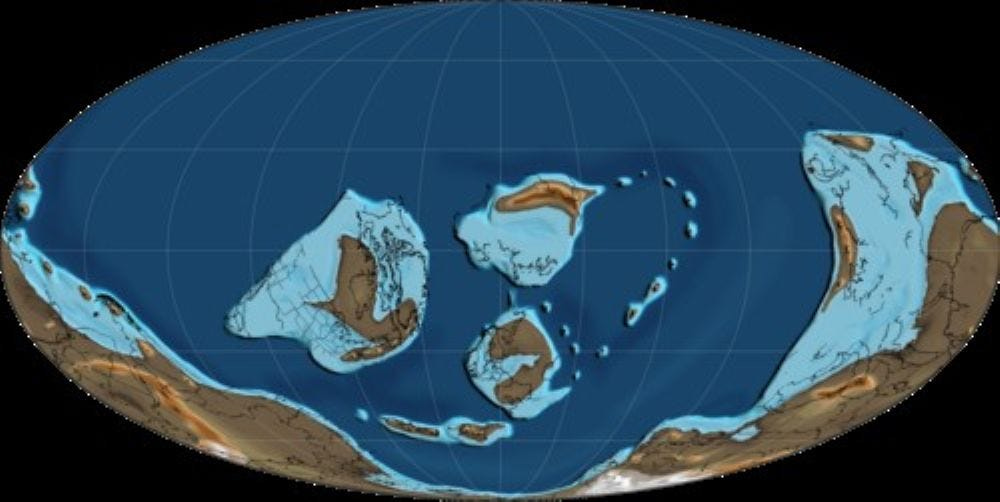
This one was caused by falling CO2 levels and a period of intense cooling. It is considered the second-worst mass extinction event in Earth’s history, causing the loss of 25% of marine families, 60% of marine genera, and 85% of marine species.
It’s believed that the tectonic uplift of the Appalachian mountains (once higher than the Himalayas) created lots of geologic weathering and sequestration of CO2. As CO2 levels fell the planet got a LOT colder and things died.
· Devonian (The Age of Fishes) Extinction: 365 million years ago.
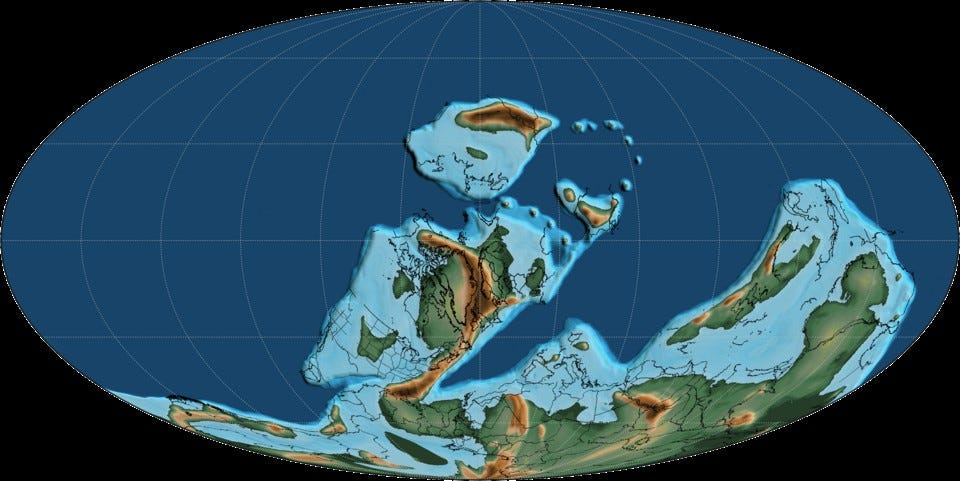
This extinction was not a single event but a series of pulses that unfolded over millions of years. The most significant pulse known as the Kellwasser event, occurred around 372 million years ago. This was a SLOW extinction, the event may have spanned several million years, with estimates ranging from 500,000 to 25 million years.
The exact causes of the Late Devonian extinction are still debated, but theories suggest a combination of factors, primarily:
Oceanic Anoxia: A lack of oxygen in the oceans, likely triggered by nutrient runoff from the expansion of land plants, is a leading hypothesis.
Global Cooling: Evidence suggests periods of cooling may have occurred, possibly triggered by changes in atmospheric CO2 levels due to plant expansion.
So basically, plants expanded across the land and sucked CO2 out of the atmosphere while breaking up rocks and releasing nutrients. Runoff from these nutrients caused massive algal blooms in the oceans. Which sucked so much oxygen from the oceans that approximately 70–85% of marine life died.
· Permian-Triassic Extinction (The Great Dying): 252 million years ago.

The “Great Dying,” was the most severe mass extinction event in Earth’s history, wiping out approximately 90% of the planet’s species. The primary causes are attributed to massive volcanic activity in Siberia leading to climate warming and ocean acidification.
CO2 levels went up to +2500ppm and the oceans warmed up to +40°C (104°F) at the equator. The Global Meant Surface Temperature was about 32°C (90°F) and the South Polar ice cap melted completely.
This was a spate of articles last week discussing the Permian-Triassic extinction.
The 'Great Dying' wiped out 90% of life, then came 5 million years of lethal heat. New fossils…A mass extinction event wiped out around 90% of life. What followed has long puzzled scientists: The planet became…www.cnn.com
Around 250 million years ago, Earth was near-lifeless and locked in a hothouse state. Now…The answer confirms scientists' suspicion that when our planet's climate crosses certain 'tipping points', truly…theconversation.com
They were in response to this paper in Nature.
Early Triassic super-greenhouse climate driven by vegetation collapse - Nature Communications….The Permian-Triassic Mass Extinction (PTME), the most severe crisis of the Phanerozoic, has been attributed to intense…www.nature.com
Here's what the paper states:
“Here, we explore a further mechanism for elevated Early Triassic temperatures that is closely tied to the timeframe of extreme warmth. This approach is based on the concept of an ‘upper temperature steady state’, in which a change in the Earth system caused the climate-carbon cycle to stabilize at a much higher global temperature for millions of years.”
They think that if it gets hot enough, so much of the plant life dies off that the Climate System gets “locked into” a hothouse state for a prolonged period.
“Specifically, we investigate the hypothesis that the key driver of the transition to a super greenhouse Earth was the dramatic and prolonged reduction of low-latitude terrestrial biomass caused by the PTME and its delayed recovery. Tropical peat-forming ecosystems are responsible for substantial drawdown of CO2, but these extensive biomes were lost at the end of the Permian.”
Basically they think it got so hot that almost all of the tropical jungles (low-latitude terrestrial biomass) DIED. These died, then burned and released all the CO2 they sequestered back into the atmosphere.
Once these forests were gone, there was nothing to draw that CO2 back out of the atmosphere and sequester it in tropical peats again. So, it stayed HOT for a really long time.
“Indeed, plant species richness and abundance dropped significantly during the Permian–Triassic transition, which is the only genuine mass extinction level event of land plants through the whole Phanzerzoic. Leaving a multimillion year “coal gap” in the Early to Middle Triassic where terrestrial plant materials did not build up as peat.”
It stayed “so hot” for “so long” that most of the planet turned to desert and most life on land and in the oceans died. There was so little plant life that it left a “multimillion year “coal gap” in the Early to Middle Triassic where terrestrial plant materials “did not build up as peat”.
Here's how CNN reported the paper.
The Great Dying has been attributed to a period of volcanic activity in a region known as the Siberian Traps, which released huge amounts of carbon and other planet-heating gases into the atmosphere, causing intense global warming. Enormous numbers of marine and land-based plants and animals died, ecosystems collapsed and oceans acidified.
What has been less clear, however, is why it got so hot and why “super greenhouse” conditions persisted for so long, even after volcanic activity ceased.
Scientists from the University of Leeds in England and the China University of Geosciences thought the answer may lie in a climate tipping point: the collapse of tropical forests.
The Great Dying extinction event is unique “because it’s the only one in which the plants all die off,” said Benjamin Mills, a study author and a professor of Earth system evolution at the University of Leeds.
They analyzed the fossils and rock formations to get clues about climate conditions in the past, allowing them to reconstruct maps of plants and trees living on each part of the planet before, during and after the extinction event. “Nobody’s ever made maps like these before,” Mills told CNN.
The results confirmed their hypothesis, showing that the loss of vegetation during the mass extinction event significantly reduced the planet’s ability to store carbon, meaning very high levels remained in the atmosphere for an extended period of time.
Forests are a vital climate buffer as they suck up and store planet-heating carbon. They also play a crucial role in “silicate weathering,” a chemical process involving rocks and rainwater — a key way of removing carbon from the atmosphere. Tree and plant roots help this process by breaking up rock and allowing fresh water and air to reach it.
Once the forests die, “you’re changing the carbon cycle,” Mills said, referring to the way carbon moves around the Earth, between the atmosphere, land, oceans and living organisms.
Michael Benton, a professor of paleontology at the University of Bristol, who was not involved in the study, said the research shows “the absence of forests really impacts the regular oxygen-carbon cycles and suppresses carbon burial and so high levels of CO2 remain in the atmosphere over prolonged periods,” he told CNN.
It highlights “a threshold effect,” he added, where the loss of forests becomes “irreversible on ecological time scales.” Global politics currently revolve around the idea that if carbon dioxide levels can be controlled, damage can be reversed. “But at the threshold, it then becomes hard for life to recover,” Benton said.
This is a key takeaway from the study. It shows what might happen if rapid global warming causes the planet’s rain forests to collapse in the future — a tipping point scientists are very concerned about.
This study is a warning, “There is a tipping point there. If you warm tropical forests too much, then we have a very good record of what happens. And it’s extremely bad.”
Here’s how The Conversation reported the paper.
The trigger for the Permian–Triassic mass extinction event was the eruption of massive amounts of molten rock in modern day Siberia, named the Siberian Traps.
On land it is thought surface temperatures increased by as much as +10°C to +14°C (from 18°C (64°F) to around 30°C (86°F)) too rapidly for many life forms to evolve and adapt.
In other similar eruptions, the climate system usually returns to its previous state within 100,000 to a million years. But these “super greenhouse” conditions, which resulted in equatorial average surface temperatures upwards of 34°C (93°F) persisted for roughly five million years. In our study we sought to answer why.
We analysed how the biomes changed from just before the mass extinction event, until about eight million years after.
We hypothesised that Earth warmed too rapidly, leading to the dying out of low- to mid-latitude vegetation, especially the rainforests. As a result the efficiency of the organic carbon cycle was greatly reduced immediately after the volcanic eruptions.
Plants, because they are unable to simply get up and move, were very strongly affected by the changing conditions.
Before the event, many peat bogs and tropical and subtropical forests existed around the equator and soaked up carbon. However, when we reconstructed plant fossils from fieldwork, records and databases around the event we saw that these biomes were completely wiped out from the tropical continents. This led to a multimillion year “coal gap” in the geological record.
The tropical forests were replaced by tiny lycopods, only two to 20 centimetres in height. Nothing would have been growing higher than your knees by the end of the Permian and Early Triassic.
Enclaves of larger plants remained towards the poles, in coastal and in slightly mountainous regions where the temperature was slightly cooler. After about five million years they had mostly recolonised Earth. However these types of plants were also less efficient at fixing carbon in the organic carbon cycle.
We found that the initial increase in temperature from the Siberian Traps was preserved for five to six million years after the event because of the reduction in net primary productivity.
It was only as plants re-established themselves and the organic carbon cycle restarted that Earth slowly started to ease out of the super greenhouse conditions.
It’s always difficult to draw analogies between past climate change in the geological record and what we’re experiencing today. That’s because the extent of past changes is usually measured over tens to hundreds of thousands of years while at present day we are experiencing change over decades to centuries.
A key implication of our work, however, is that life on Earth, while resilient, is unable to respond to massive changes on short time scales without drastic rewirings of the biotic landscape. — Zhen Xu lead author of the study.
In the case of the Permian–Triassic mass extinction, plants were unable to respond on as rapid a time scale as 1,000 to 10,000 years. This resulted in a large extinction event.
WE ARE AT 430PPM ATMOSPHERIC CO2 RIGHT NOW.
The rate of CO2 increase has been +3ppm per year for the last 3 years in a row.
We will be at +500ppmCO2 by 2050.
The decline in the planetary albedo has increased the ENERGY going into the Climate System to +1.7W/m2 according to James Hansen.
That has the same effect as adding +138ppm of CO2 to the atmosphere SINCE 2014.
The level of atmospheric CH4 has increased +179ppb since 2000. CH4 levels are now around +1900ppb. The HIGH for the last million years was never more than about 700ppb.
The increase in CO2 since 1850 has the same effect as adding +100ppm of CO2 to the atmosphere.
IF these two forcings remain stable between now and 2050.
We could reach a CO2e level of about +750ppm by 2050.
This puts us in VERY DANGEROUS territory.
You might remember that CNN reported on another paper last fall related to the Permian extinction.
Mega El Niño instigated the end-Permian mass extinction
Science, 12 Sep 2024, Vol 385, Issue 6714 pp. 1189–1195
Mega El Niño events may have caused planet's greatest mass extinction | CNN…..Mega El Niños could have intensified the world's most devastating mass extinction, which ended the Permian Period 252…www.cnn.com
Here's something from the paper’s Abstract.
As atmospheric partial pressure of carbon dioxide doubled from about 410 to about 860 ppm (parts per million) in the latest Permian, the meridional overturning circulation collapsed, the Hadley cell contracted, and El Niños intensified.
The resultant deforestation, reef demise, and plankton crisis marked the start of a cascading environmental disaster. Reduced carbon sequestration initiated positive feedback, producing a warmer hothouse and, consequently, stronger El Niños. The compounding effects of elevated climate variability and mean state warming led to catastrophic but diachronous terrestrial and marine losses.
The “cascading environmental disaster” started at around +860ppmCO2. FAR below the +2500ppmCO2 level that would ultimately be reached.
By 2050 we will be at around 750ppmCO2e. At a +3ppm/year rate of increase we will reach 860ppmCO2e around 2085.
Assuming things don't accelerate.

We could see a Rate of Warming as high as +0.5°C per decade by 2050. Warming of +6°C up to +7°C by 2100 is ENTIRELY possible. These next 10–15 years are our LAST CHANCE to collectively take actions to slow this disaster down and try to mitigate it.
And the MAGAts just stepped on the gas.
Republicans' 'One Big Beautiful Bill' Not So Beautiful for the Climate…..Four research firms project that the Republicans' One Big Beautiful Bill Act will raise greenhouse gas emissions and…www.scientificamerican.com
End Part One.
This is my analysis.
This is what I see.
This is my “Crisis Report”.
rc 07/07/2025
ADDENDUM:
You might remember my graph from The Crisis Report - 052 - Unclothing the Emperor : Understanding “What’s Wrong” with our “Climate Paradigm”. Part 2 - Acceleration of the Rate of Warming (RoW). (11/07/23)
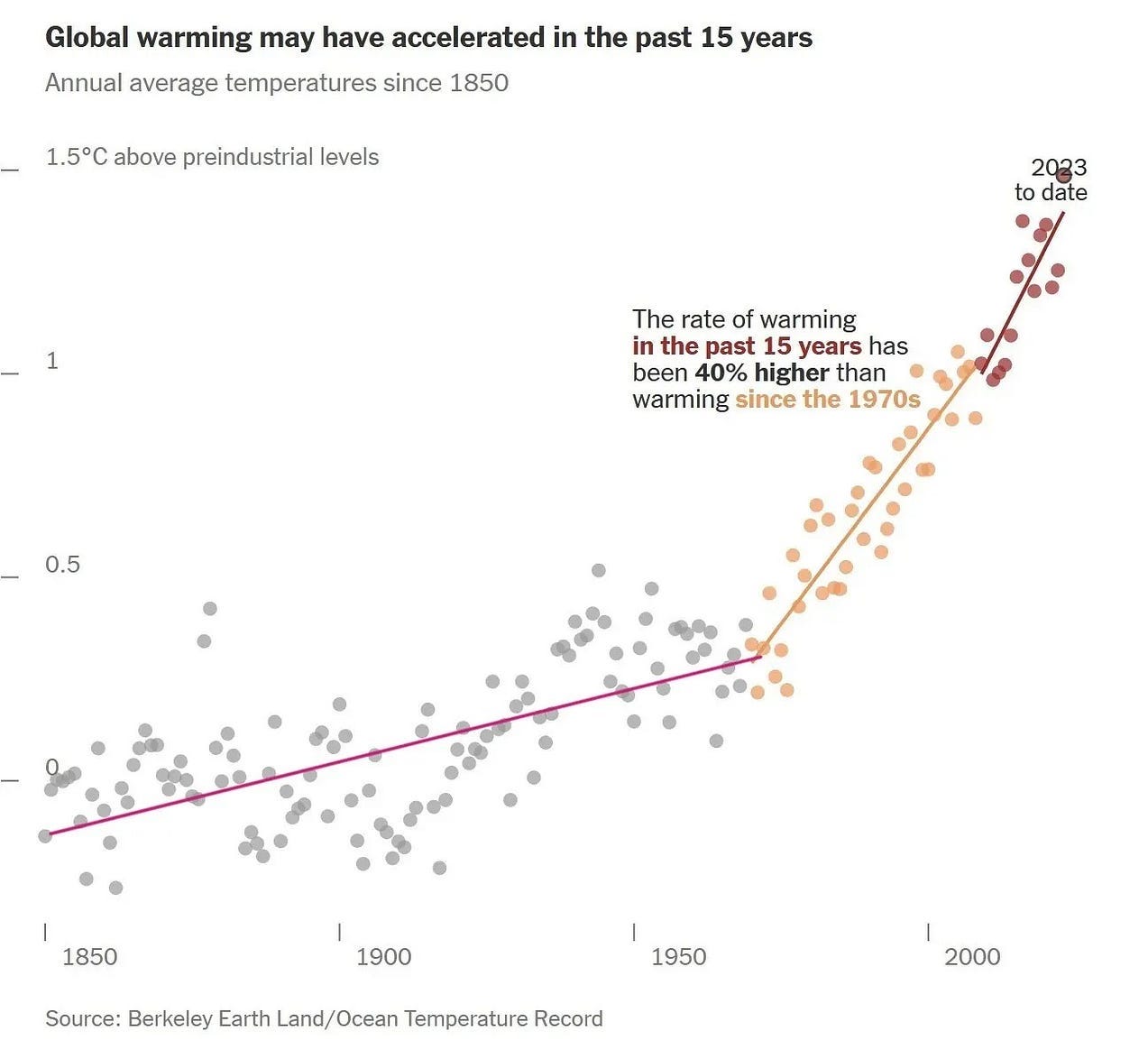
At that time mainstream Climate Science was still insisting that the Rate of Warming WAS NOT accelerating. Well, in just 18 months the “Alarmist” position has now become “mainstream”.
Part Two of this series will cover three additional extinction events, the End Triassic, the End Cretaceous, and the PETM. Each of them has similarities that speak to how the overall Climate System works as well as unique aspects that have relevance to what's happening today.
Lastly, the book “The Sixth Extinction: An Unnatural History” by Elizabeth Kolbert (2014) is still an excellent introduction to the ongoing Mass Extinction event currently taking place.
After researching the current mainstream view of the relevant peer-reviewed science, Kolbert estimates flora and fauna loss by the end of the 21st century to be between 20 and 50 percent “of all living species on earth”.




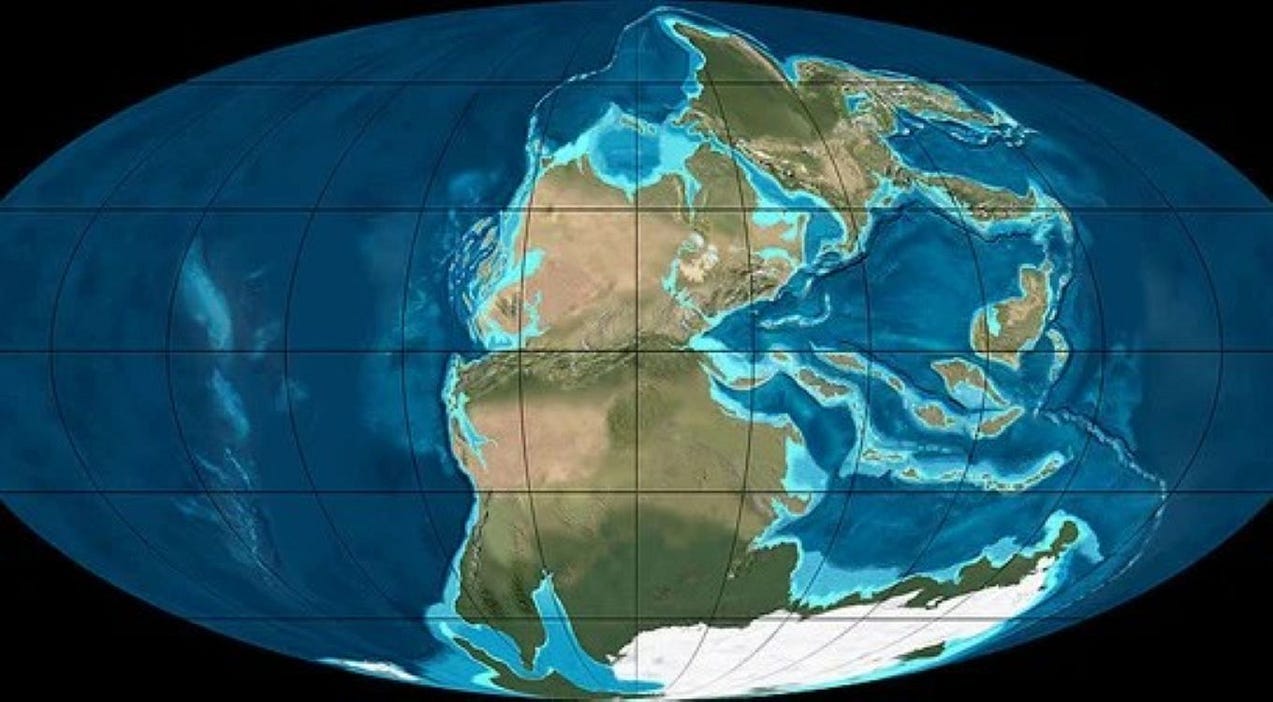
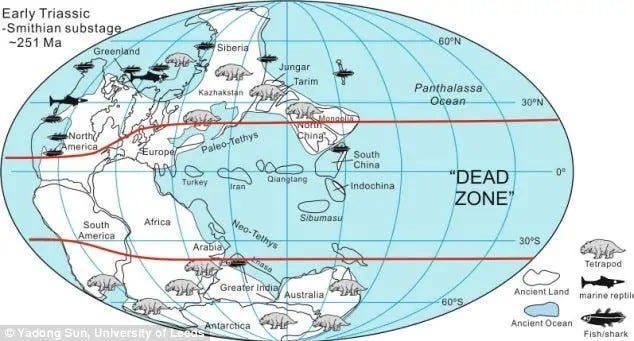
I keep telling people that everyone is dead before the end of this century. Nobody believes me. Most get pretty emotional and defensive about it. Angry or aggressive towards me. It’s unfortunately obvious at this point. This planet has been destabilized in a way that has it square in the process of rendering it unable to support complex life for a long time.
Large systems can withstand a lot of fluctuations. But they’re not invincible. Enough of a percentage of the whole system changes and it becomes a new system.
Any human walking around in the 22nd century will be one of few if any, and that existence is gonna be grueling if so.
Excellent post, I appreciate information of this depth on Substack. 👏